I recently read Jane Austen’s Pride and Prejudice, probably her most popular novel. The style is clear, the plot easy to follow; it’s never dull, and not very long. It’s easy to see why it’s popular. Austen focuses on people — their feelings, conversations, actions — and spends little time on descriptions of furniture, curtains, flowers, etc. Perhaps we can explain her popularity by saying “people are interested in people.” Austen seems to enjoy writing, and this adds to our enjoyment of her works.
Her language is clear but not colloquial; one might describe it as literary language, formal and stilted by today’s standards. For example, here’s how Mr. Collins speaks to Mrs. Bennet when he wants to marry Mrs. Bennet’s daughter: “May I hope, madam, for your interest with your fair daughter Elizabeth, when I solicit for the honour of a private audience with her in the course of this morning?”
The first novel Austen published was Sense and Sensibility, which she published at her own expense in 1811. She published three more novels before she died in 1817, at the age of 41. After her death, one of her brothers published her last two novels. She was quite a popular novelist in her day; one of her fans was Walter Scott. Her name wasn’t known, though, since she published anonymously. It seems that the first novel she started was Pride and Prejudice, which was initially called First Impressions. A writer’s first book is often their best, the clearest expression of their deepest feelings.
Austen depicts upper-middle-class English society. She takes no daring flights of imagination, creates no dream worlds; she stays close to everyday life. As Walter Scott said, writers like Austen are “copying from nature as she really exists in the common walks of life, and presenting to the reader, instead of the splendid scenes of an imaginary world, a correct and striking representation of that which is daily taking place around him.”1 Perhaps Austen would be surprised if she knew that she’s far more popular today than Scott, whose novels were set in past ages. One might say that Austen is the opposite of Tolstoy and Dostoyevsky because they try to transcend everyday life through mystic ecstasy or sudden enlightenment. Austen is like a basketball player who makes no spectacular shots, but has good “shot selection,” never forces a shot, never tries to do more than he’s capable of.
She has no truck with the dark passions of the Romantic school. She has more in common with pre-Romantic writers like the rational moralist Samuel Johnson (she was a fan of Johnson). She often uses the word “rational” as a positive term; for example, when Mr. Bennett is annoyed with Kitty, he says, “you are never to stir out of doors till you can prove that you have spent ten minutes of every day in a rational manner.”
The 2005 film version of Pride and Prejudice is faithful to the novel, and includes several English country houses and landscape gardens. Visit the film’s website for information on the houses and landscapes.1B
Austen’s philosophical remarks are often impressive. As A. C. Bradley wrote, “Like Johnson, [Austen is] a moralist. Her morality [is] not merely embodied in her plots, it is often openly expressed.... Her explicit statements and comments are often well worth pondering.”2
Her philosophy might be described as Johnsonian Stoicism. She tells us not to live in the past and the future, not to live on hopes and regrets. When Darcy is regretting a letter he wrote, Elizabeth tells him, “You must learn some of my philosophy. Think only of the past as its remembrance gives you pleasure.” A wise maxim, but not easy to follow!
When Elizabeth tells her father not to let Lydia go to Brighton, her father doesn’t follow her advice. Elizabeth is stoical: “It was not in her nature... to increase her vexations by dwelling on them. She was confident of having performed her duty, and to fret over unavoidable evils, or augment them by anxiety, was no part of her disposition.”
[Spoiler Warning: If you’re thinking of reading Pride and Prejudice, I suggest you skip the rest of this section.] Sometimes the stoicism of Austen’s characters is tested by everyday annoyances, as when Mrs. Bennett complains constantly about Bingley abandoning Jane: “It needed all Jane’s steady mildness to bear these attacks with tolerable tranquillity.”
Instead of getting annoyed by the comments of the people around us, Austen says, we can find amusement in them. Mr. Bennett finds amusement in his wife:
| To his wife he was very little otherwise indebted, than as her ignorance and folly had contributed to his amusement. This is not the sort of happiness which a man would in general wish to owe to his wife; but where other powers of entertainment are wanting, the true philosopher will derive benefit from such as are given. |
Austen describes the folly of living in the future, living in hope; this is a favorite Stoic theme. Elizabeth is eager for Wickham to leave town, but
| she found, what has been sometimes found before, that an event to which she had been looking with impatient desire did not, in taking place, bring all the satisfaction she had promised herself. It was consequently necessary to name some other period for the commencement of actual felicity — to have some other point on which her wishes and hopes might be fixed, and by again enjoying the pleasure of anticipation, console herself for the present, and prepare for another disappointment. Her tour to the Lakes was now the object of her happiest thoughts. |
Austen reminds me of Freud insofar as she believes that the feeling of guilt plays a key role in human nature, and human suffering. When Elizabeth fails to publicize Wickham’s wickedness, and Wickham elopes with Lydia, Elizabeth feels “the keenest of all anguish, self-reproach.” Surely this is one of Austen’s best aphorisms. When Mr. Bennett blames himself for letting Lydia go to Brighton, Elizabeth tries to raise his spirits: “You must not be too severe upon yourself,” Elizabeth says. Mr. Bennett responds, “You may well warn me against such an evil. Human nature is so prone to fall into it!” One wonders where Austen acquired her understanding of guilt. Did this understanding come from her own experience, or from a philosophical writer like Johnson, or both?
Darcy blames himself for the haughty style of his first proposal to Elizabeth. He says to Elizabeth,
| Your reproof, so well applied, I shall never forget: “had you behaved in a more gentlemanlike manner.” Those were your words. You know not, you can scarcely conceive, how they have tortured me — though it was some time, I confess, before I was reasonable enough to allow their justice. |
Darcy’s feeling of guilt may be a healthy emotion since it makes him humbler, makes him a better person. Wisdom comes through suffering, so if the keenest suffering is self-reproach, then self-reproach may be our best teacher. As Darcy says, “Painful recollections will intrude which cannot, which ought not, to be repelled.” Is the feeling of guilt a teacher whom we should listen to and learn from — experience to the full? Mr. Bennett says, “Lizzy, let me once in my life feel how much I have been to blame. I am not afraid of being overpowered by the impression. It will pass away soon enough.”
Darcy says that his hauteur has its roots in his early childhood: he was an only son, and an eldest child; he was spoiled and he looked down on other people. But he has been educated by Elizabeth, by her criticisms, and by his own self-reproaches:
| Such I was, from eight to eight and twenty; and such I might still have been but for you, dearest, loveliest Elizabeth! What do I not owe you! You taught me a lesson, hard indeed at first, but most advantageous. By you, I was properly humbled. I came to you without a doubt of my reception. You showed me how insufficient were all my pretensions to please a woman worthy of being pleased. |
The feeling of guilt, though painful for Darcy, may have made him a better person. Darcy is eager to show Elizabeth that he has learned, grown, improved: “I hoped to obtain your forgiveness, to lessen your ill opinion, by letting you see that your reproofs had been attended to.”
The union of Darcy and Elizabeth is a union of opposites, reminding us of the saying, “opposites attract.” We can learn from our opposite, and become more whole.
| [Elizabeth] began now to comprehend that he was exactly the man who, in disposition and talents, would most suit her. His understanding and temper, though unlike her own, would have answered all her wishes. It was an union that must have been to the advantage of both; by her ease and liveliness, his mind might have been softened, his manners improved; and from his judgment, information, and knowledge of the world, she must have received benefit of greater importance. |
As I wrote in an earlier issue, “According to Jungians, marriage means seeking wholeness by joining with someone who complements you, someone who supplies your deficiencies.” Perhaps Austen’s message is, “Marriage should be about achieving wholeness, not simply about obtaining wealth or pleasure.”
One of the themes of Pride and Prejudice is that first impressions can be deceiving; this may be why an early draft of the novel was entitled First Impressions. Elizabeth’s first impression of Darcy is negative, and her first impression of Wickham is positive. Darcy is cold on the outside, but good on the inside, while Wickham is warm on the outside, but cold on the inside. “There certainly was some great mismanagement in the education of those two young men. One has got all the goodness, and the other all the appearance of it.” Both Darcy’s goodness and Wickham’s wickedness have their origins in their early childhood, their “education.”
I hope these remarks have shown that Austen is a good philosophical writer, and her aphorisms are often impressive. Virginia Woolf said of Austen, “of all great writers she is the most difficult to catch in the act of greatness.” I hope I’ve shown that it’s possible to catch Austen in “the act of greatness.”
I read several essays about Pride and Prejudice, but I haven’t found one that I can recommend enthusiastically.
Austen works on a small scale, a domestic scale. She told her niece, an aspiring writer, “You are now collecting your people delightfully, getting them exactly into such a spot as is the delight of my life — 3 or 4 Families in a Country Village is the very thing to work on.” Austen described her work as a “small square two inches of ivory.” Her work is clear and readable; she doesn’t explore deep passions. “The prevailing tone... is brisk and dry.”3
One might say that the first half of Pride and Prejudice is about the hostility that drives Elizabeth and Darcy apart, while the second half is about their coming together. As one critic wrote,
| This pattern is formed by diverging and converging lines, by the movement of two people who are impelled apart until they reach a climax of mutual hostility, and thereafter bend their courses towards mutual understanding and amity. It is a pattern very common in fiction, but by no means easy to describe plausibly.4 |
The relationship between Elizabeth and Darcy may have been modeled after a relationship in Fanny Burney’s popular novel, Cecilia. Q. D. Leavis (wife of critic F. R. Leavis) argued that Pride and Prejudice is an attempt to “rewrite the story of Cecilia in realistic terms.” In Cecilia we find the remark, “The whole of this unfortunate business has been the result of Pride and Prejudice,” so we know where Austen got her title.5
One critic, Mark Schorer, argues that Darcy represents Pride, while Elizabeth represents Prejudice. Schorer regards Mr. Collins as a “hilarious caricature” of Pride, and Lady Catherine as a caricature of Prejudice. Like many novels, Pride and Prejudice deals with personal growth. “Elizabeth and Darcy are rewarded because they are capable of altering.... The interest of a novel... lies in the processes of human alteration.... In their alteration, [Darcy and Elizabeth] are free to merge.”
Schorer argues that, in Austen’s time, the landed aristocracy was declining, and the merchant class was rising. Austen uses marriage as a symbol of this change; the marriage between Elizabeth and Darcy, for example, is a marriage between the merchant class and the landed aristocracy. (Proust also depicted the merging of the aristocracy with the middle class, as in the marriage of Mme Verdurin with the Prince de Guermantes, and the marriage of Gilberte with Saint-Loup.) Austen also depicts “marriage as a brutal economic fact in an essentially materialistic society.” Schorer concludes that “all this is the groundwork out of which Pride and Prejudice, together with Jane Austen’s other novels, arises.”
Though Austen is highly-respected today, she has had many critics. Charlotte Bronte, for example, said
| She does her business of delineating the surface of the lives of genteel English people curiously well; there is a Chinese fidelity, a miniature delicacy in the painting: she ruffles her reader by nothing vehement, disturbs him by nothing profound: the Passions are perfectly unknown to her.... No open country, no fresh air, no blue hill. |
Emerson was also critical of Austen: “Never was life so pinched and narrow.... All that interests in any character [is], has he (or she) the money to marry with?” I hope I’ve shown that Austen deals with some large subjects, and handles them well; the fact that she places these large subjects on a small stage, on the stage of everyday life, shouldn’t make us conclude that she deals only with trivial matters.
Jane’s brother, Henry Austen, wrote a short memoir of her. He says, “She read aloud with very great taste and effect. Her own works, probably, were never heard to so much advantage as from her own mouth; for she partook largely in all the best gifts of the comic muse.” When she was growing up, literature was part of her life, and a primary means of entertainment. She began writing at a young age. She and her family also enjoyed drama, and staged their own plays.
As part of my Jane Austen study, I looked at The Great Tradition, by the famous English critic F. R. Leavis. It starts with this sentence: “The great English novelists are Jane Austen, George Eliot, Henry James and Joseph Conrad — to stop for the moment at that comparatively safe point in history.” I discovered, though, that while The Great Tradition discusses Eliot, James, and Conrad, it doesn’t discuss Austen, whom he says “needs to be studied at considerable length.”
Leavis does, however, make some general remarks about Austen in his introduction. He starts the introduction by commenting on older novelists like Defoe and Sterne, who enjoyed a certain vogue with the Bloomsbury Group (Virginia Woolf, E. M. Forster, etc.). He dismisses these older novelists; he speaks of Sterne’s “irresponsible (and nasty) trifling.” He says that Fielding is important in literary history, but he’s monotonous, simplistic. Once you start to appreciate Jane Austen, Leavis says, then you realize that “life isn’t long enough to permit of one’s giving much time to Fielding.... What [Fielding] can do appears to best advantage in Joseph Andrews.”
Leavis agrees with Samuel Johnson that Richardson has “a more inward interest” than Fielding. Leavis praises Richardson’s “analysis of emotional and moral states... Clarissa is a really impressive work.” Leavis says that Richardson’s fame spread throughout Europe, and that he helped to make Austen possible. Nonetheless, “it’s no use pretending that Richardson can ever be made a current classic again.” His work is “limited in range and variety,” and he demands too much time from the reader.
While Richardson focused on the middle class, Fanny Burney wrote about “educated life,” and thus influenced Austen more directly. “Here we have one of the important lines of English literary history: Richardson ==> Fanny Burney ==> Jane Austen. It is important because Jane Austen is one of the truly great writers, and herself a major fact in the background of other great writers.” Leavis says that a study of Austen allows us to see what’s important in Fielding, Richardson, and other earlier writers: “Her work, like the work of all great creative writers, gives a meaning to the past.” This is an astute remark, and it’s as true in philosophy as it is in fiction; an important philosopher prompts us to reinterpret the tradition.
Leavis says that Austen has “an intense moral interest of her own in life... a preoccupation with certain problems that life compels on her as personal ones.... Without her intense moral preoccupation she wouldn’t have been a great novelist.” All great novelists, according to Leavis, have this “intense moral preoccupation.” All great novelists have “an unusually developed interest in life. They are all distinguished by a vital capacity for experience, a kind of reverent openness before life, and a marked moral intensity.” One might compare Leavis’ argument with that of American novelist John Gardner, who wrote a controversial book called On Moral Fiction. “In this work, Gardner attacks what he sees as contemporary literature’s lack of morality, which he calls the highest purpose of art.”(Wikipedia)
Leavis has little respect for Walter Scott: “Of his books, The Heart of Midlothian comes the nearest to being a great novel, but hardly is that.” As for the fiction of H. G. Wells, Leavis says that Wells discusses problems and ideas, but a great novelist embodies problems and ideas in his fiction. Leavis has some praise for Arnold Bennett, but says “Bennett seems to me never to have been disturbed enough by life to come anywhere near greatness.” I like the phrase “disturbed by life”; a writer who is disturbed by life has an “intense moral preoccupation.” A moral preoccupation should not be confused with moralizing, with preaching. Proust, for example, is preoccupied with life — with obsessive love, with grief, etc. — but he doesn’t moralize.
Leavis says that Austen’s famous irony has a “serious background,” and is related to Austen’s “essential moral interest.” I’m reminded of Kierkegaard’s view that Socrates’ famous irony was related to his moral interest, his moral passion. As I wrote in an earlier issue, “In his book The Concept of Irony, Kierkegaard argued that the famous irony of Socrates wasn’t based on indifference or cynicism, but rather on depth of spirit, ethical passion.”
In passing, Leavis praises T. F. Powys, saying that he’s under-rated, and that he has a genuine creative gift. T. F. Powys was known for his novels and short stories; since he wrote allegory and fantasy, he’s sometimes compared to C. S. Lewis.
His brother, John Cowper Powys, was also well-respected as a fiction writer. In addition to fiction, John Cowper Powys wrote numerous books of popular philosophy (casual philosophy), such as The Art of Happiness and The Art of Growing Old. He also wrote several books of literary criticism, which are said to be “full of the author’s infectious enthusiasm for literature.”6 He spent many years in the U.S., traveling and lecturing.
John Cowper Powys had a deep interest in the occult. I received an e-mail about him:
| From the age of three, John Cowper Powys (1872-1963) wanted to be a magician. Later in life, Jack (as he was known to his friends) became convinced that he had the power to harm people by simply willing them harm. This frightened him to the extent that he forced himself to act and feel benevolence towards all people.... Powys was obsessed with the magician as occultist starting with “Bloody” Johnny Geard in A Glastonbury Romance, who cures a woman named Petherton of terminal cancer (though it takes three mighty passes). |
Powys is a Welsh name, and there’s a county in Wales called Powys. John Cowper Powys had a deep interest in Wales, and lived there for the last thirty years of his life. He wrote a historical novel about the Welsh hero Owen Glendower, who led a rebellion against England around 1400, and he wrote a historical novel called Porius, which is set in Wales around 500 AD.
I first heard the name “Powys” when I was studying G. Wilson Knight, who wrote a critical study of John Cowper Powys (The Saturnian Quest: A Chart of the Prose Works of John Cowper Powys). A third Powys brother, Llewelyn, was also an author. Students of Birth Order might find it interesting that the eldest of the three Powys brothers (John Cowper Powys) seemed to have the most talent. The Powys brothers (and their talented siblings) were descended from the poet William Cowper.
I recently bought a Kindle from Amazon. Since I like to make notes and highlights while I read, I was attracted by the Kindle’s ability to collect your notes/highlights, and store them in the cloud. The Kindle’s motto is “Read. Review. Remember.” The Kindle’s logo is a person reading under a tree at night; with an e-reader, you don’t need a light to read. And the Kindle is more than an e-reader, it’s a convenient way to check e-mail, surf the web, etc.
Amazon sells the Kindle for a low price because they hope to make money selling books, movies, etc. Amazon tries to force you to use their software — their e-mail program, their AppStore, etc., etc. The only way to access Google’s AppStore (Google Play) is to “root” your Kindle, which voids your warranty, and doesn’t always go smoothly. I managed to load Gmail without rooting (through a process called “sideloading”); I also loaded a browser called Dolphin, and Adobe Flash.
Some e-books have lots of little mistakes, lots of typos, because they’re made by scanning, the OCR software is imperfect, and nobody bothers to proof-read. This problem seems to affect contemporary books more than classics. Since classics were digitized decades ago, there has been time to remove mistakes. I recommend a publisher of e-books called Delphi Classics; they sell the Complete Works of many well-known writers. Their volume of D.H. Lawrence contains not only his works, but two biographies of him.
Project Gutenberg offers free e-books, and many of their e-books are available in Kindle format. But there’s a disadvantage to a Kindle book from Gutenberg: your notes and highlights won’t be stored in Amazon’s cloud, they’ll only be stored on your device. So it’s probably best to get your e-books from Amazon. If you download a book in pdf format, you can make highlights/notes with Adobe Acrobat, and store a copy of the file at cloud.acrobat.com.
Update January, 2014: I tried iBooks, Apple’s reading program. It has the look-and-feel of Kindle: you can easily look up words in a dictionary or Wikipedia, you can highlight passages, you can make notes, etc. It will probably store your notes/highlights, and sync them across all your Apple devices. So far, so good. But it doesn’t seem to work with Windows or Android, so it’s only good for people who are entirely Apple.
Many apps are available for iPhone and Android, but not for Kindle, so it may be a mistake to buy a Kindle. It might be wise to buy an Android or Apple tablet, and run the Kindle app on it, instead of buying a Kindle. Or perhaps you can run the Kindle app on your cell phone, and not use a tablet at all.
Update August 2021: I recently bought the Kindle version of Robert Richardson’s biography of William James. It was $14, the Google version was $19. Maybe Amazon has more leverage with publishers, and is able to negotiate lower prices? Or maybe they’re willing to sell e-books at a smaller markup?
If I read a book whose copyright has expired, such as William James’ essays, I download the epub version at gutenberg.org, then open it in Google Books. The Google software is slightly better than Kindle, less proprietary than Kindle. For example, when you copy-and-paste from Kindle into Word, you get a copyright notice as well as the text you copied, but with Google, you get only the text you copied. Here’s what Kindle’s copyright notice looks like:
Richardson, Robert D.. William James: In the Maelstrom of American Modernism (p. 193). Houghton Mifflin Harcourt. Kindle Edition.
Adobe’s pdf format is clumsy for highlighting, note-taking, and copy-and-paste. But some books are only available in pdf format, so you have no choice. Some publishers may not want to make it easy to copy-and-paste, they want to have some control of their content, so they release it in pdf form.
A. When I read Pride and Prejudice, I noticed that the word “post” had a different meaning in Austen’s day. I did some research, and found that the original meaning of “post” is probably the literal meaning — a wooden post, a post to which a horse could be tied, a hitching post. If a medieval king wanted to improve communications in his kingdom, he would build a road, and place a post every eight miles or so. Fresh horses would be available at each post, so a courier could move swiftly along the road. So the post was to horse travel what a gas station is to car travel. The person in charge of maintaining the posts and the horses was the postmaster. The road was called a “post road.” From carrying the king’s messages, the post road evolved to carrying everyone’s messages; it became a postal system. Travelers could hire fresh horses at a post. Over time, a post might acquire an inn, a tavern, a store, a village. The Oxford English Dictionary has much to say about “post.”
Perhaps the first “post road” was built by the Persians about 500 BC; it’s sometimes called The Royal Road. It was about 1,700 miles long, and the king’s couriers traversed it in 7 days (about 250 miles per day). The Greek historian Herodotus said, “There is nothing in the world that travels faster than these Persian couriers. Neither snow nor rain nor heat nor gloom of night stays these couriers from the swift completion of their appointed rounds.”
B. In a recent issue, I discussed how people are using advanced statistics to study baseball, elections, etc. Perhaps the most famous baseball statistician is Bill James, who calls his work “sabermetrics” (from SABR, the Society for American Baseball Research). The most famous basketball statistician is Ken Pomeroy. At the start of the recent college basketball tournament, Pomeroy ranked Florida as the best team in the country because of their margin of victory: their losses were by only a few points, their victories by large margins. Like Bill James, Pomeroy looks at “the numbers behind the numbers.” There’s an annual conference on sports statistics called MIT Sloan Sports Analytics Conference.
C. I discovered a Harvard historian named Ann Blair, a specialist in intellectual history (and perhaps the history of science). Blair is best known for a book called Too Much to Know: Managing Scholarly Information before the Modern Age. She was a graduate student of Anthony Grafton, who’s known for books about Renaissance intellectual life.
I think Blair was also a student of Robert Darnton. Wikipedia calls Darnton “a pioneer in the field of the history of the book.” Most of Darnton’s books deal with France in the 18th century. Darnton is best known for The Great Cat Massacre and Other Episodes in French Cultural History. His first book was Mesmerism and the End of the Enlightenment in France.
Philology: The Forgotten Origins of the Modern Humanities by James Turner, surveys the history of philology, from antiquity to the present. Turner praises generalists like Casaubon and Scaliger, and criticizes the modern tendency toward specialization. (Another generalist from the EarlyModern period is Athanasius Kircher; Paula Findlen edited a book called Athanasius Kircher: The Last Man Who Knew Everything.)
D. I discovered a Harvard professor named Gregory Nagy, who specializes in Homer and other early Greek poets. Though I didn’t hear his name when I was at Harvard in the early 1980s, he has taught a popular course about the Greek hero for many years, and his course is now being offered as a Massive Open Online Course (MOOC). Among his books is The Best of the Achaeans: Concepts of the Hero in Archaic Greek Poetry (1998).
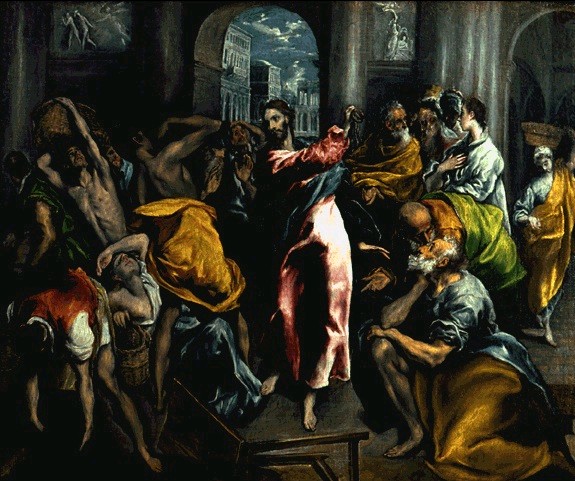
Scourging the Moneychangers from the Temple
El Greco
And they come to Jerusalem: and Jesus went into the temple, and began to cast out them that sold and bought in the temple, and overthrew the tables of the moneychangers, and the seats of them that sold doves.... And he taught, saying unto them, Is it not written, My house shall be called of all nations the house of prayer? but ye have made it a den of thieves. (Mark 11, 15-17)
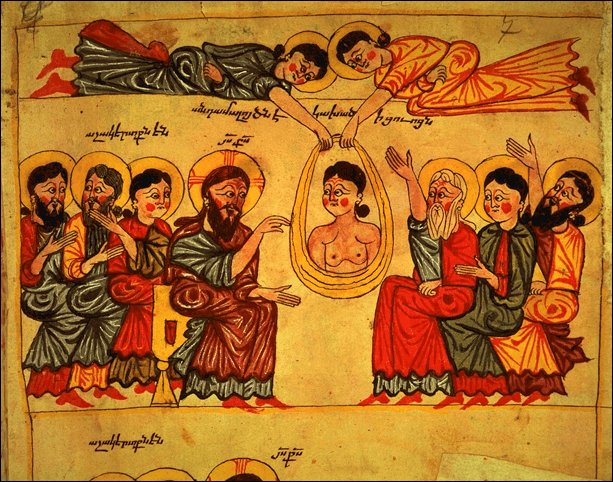
The Lame Man
anonymous Armenian artist
He entered into Capernaum after some days; and it was noised that he was in the house. And straightway many were gathered together, insomuch that there was no room to receive them, no, not so much as about the door: and he preached the word unto them. And they come unto him, bringing one sick of the palsy, which was borne of four. And when they could not come nigh unto him for the press, they uncovered the roof where he was: and when they had broken it up, they let down the bed wherein the sick of the palsy lay. (Mark 2, 1-4)
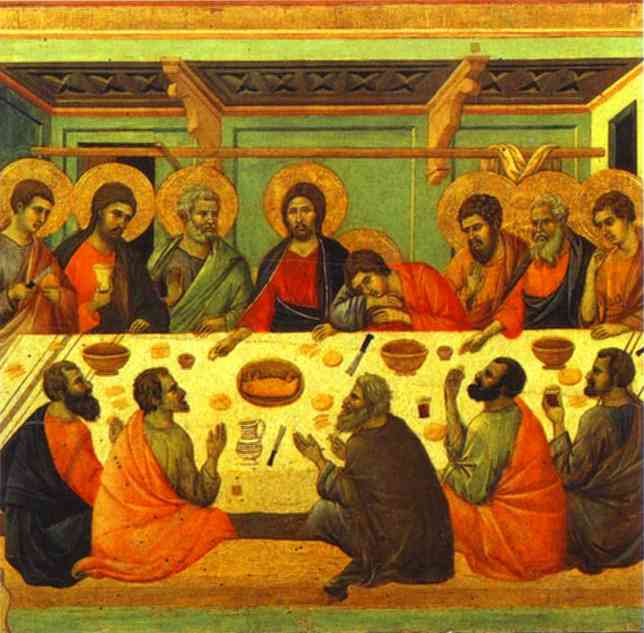
The Last Supper
Duccio di Buoninsegna
Now when the even was come, he sat down with the twelve. And as they did eat, he said, Verily I say unto you, that one of you shall betray me. And they were exceeding sorrowful, and began every one of them to say unto him, Lord, is it I? And he answered and said, He that dippeth his hand with me in the dish, the same shall betray me.... And as they were eating, Jesus took bread, and blessed it, and brake it, and gave it to the disciples, and said, Take, eat; this is my body. And he took the cup, and gave thanks, and gave it to them, saying, Drink ye all of it; For this is my blood of the new testament, which is shed for many for the remission of sins. (Matthew 26, 20-28)
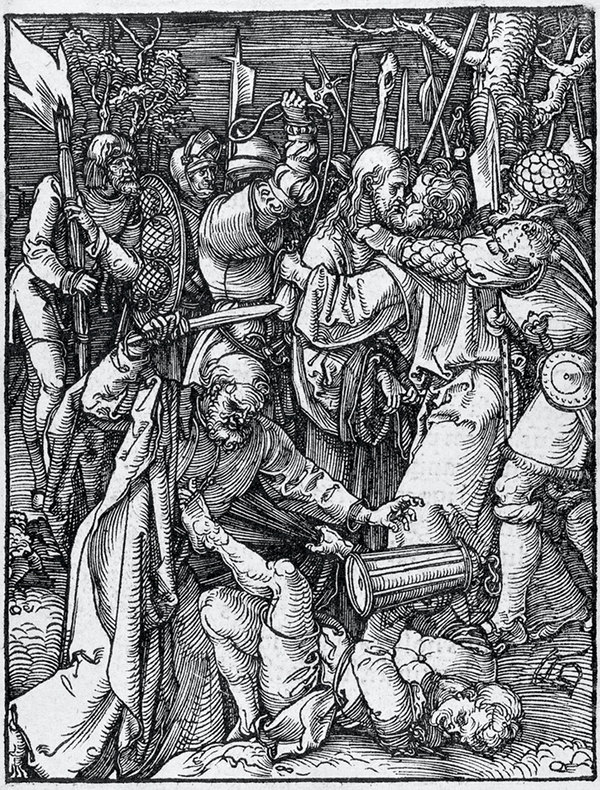
The Betrayal of Christ
Durer
Behold a multitude, and he that was called Judas, one of the twelve, went before them, and drew near unto Jesus to kiss him. But Jesus said unto him, Judas, betrayest thou the Son of man with a kiss? When they which were about him saw what would follow, they said unto him, Lord, shall we smite with the sword? And one of them smote the servant of the high priest, and cut off his right ear.... Then took they him, and led him, and brought him into the high priest’s house. (Luke 22, 48-54)
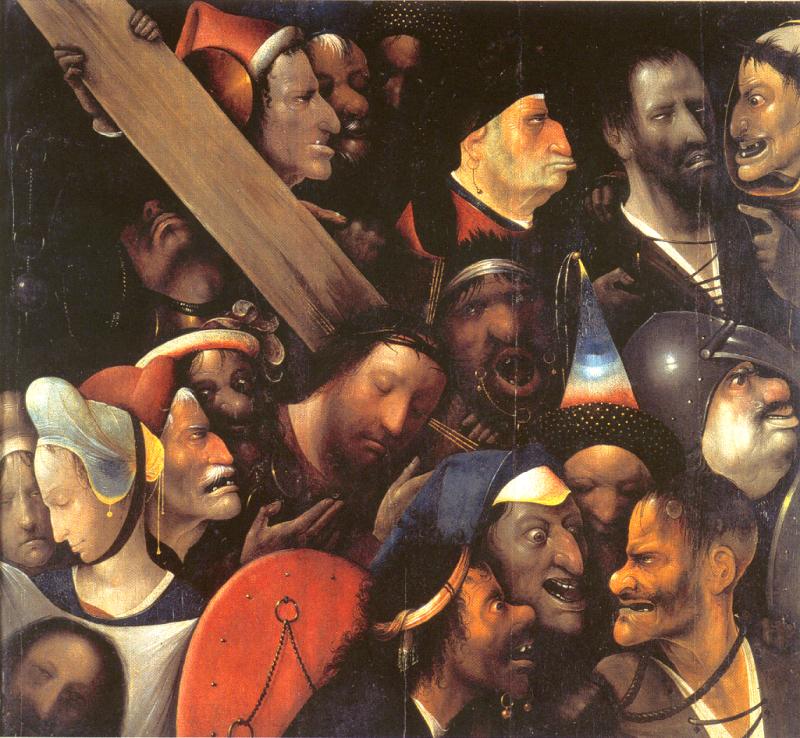
Veronica
Bosch
Veronica is in the lower-left corner of Bosch’s painting, with her veil stamped with the image of Jesus. “Veronica was moved with pity when she saw Jesus carrying his cross and gave him her veil that he might wipe his forehead. Jesus accepted the offering and after using it handed it back to her, the image of his face miraculously impressed upon it.” (Wikipedia) “Veronica” means true image (vera icon).
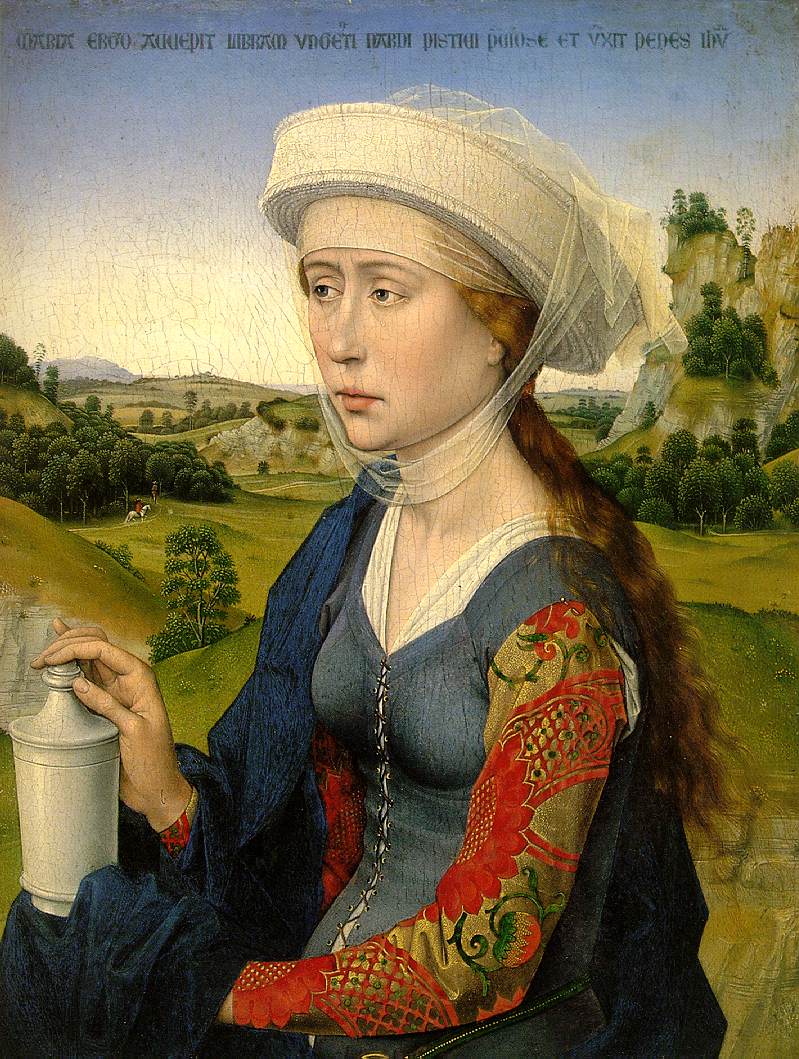
Mary Magdalene
Rogier van der Weyden
Mary Magdalene is often depicted with a jar of ointment. The text along the top of the painting is from John 12:3, and reads “Maria ergo accepit libram ungenti nardi pistici, pretiosi, et unxit pedes Iesu” (then took Mary a pound of ointment of spikenard, very costly, and anointed the feet of Jesus).
The Four Evangelists — Matthew, Mark, Luke, and John — are often depicted with their symbols — the angel, the lion, the calf, and the eagle. These symbols originate with a passage in Revelation: “And the first beast was like a lion, and the second beast like a calf, and the third beast had a face as a man, and the fourth beast was like a flying eagle.” (Revelation 4, 7)
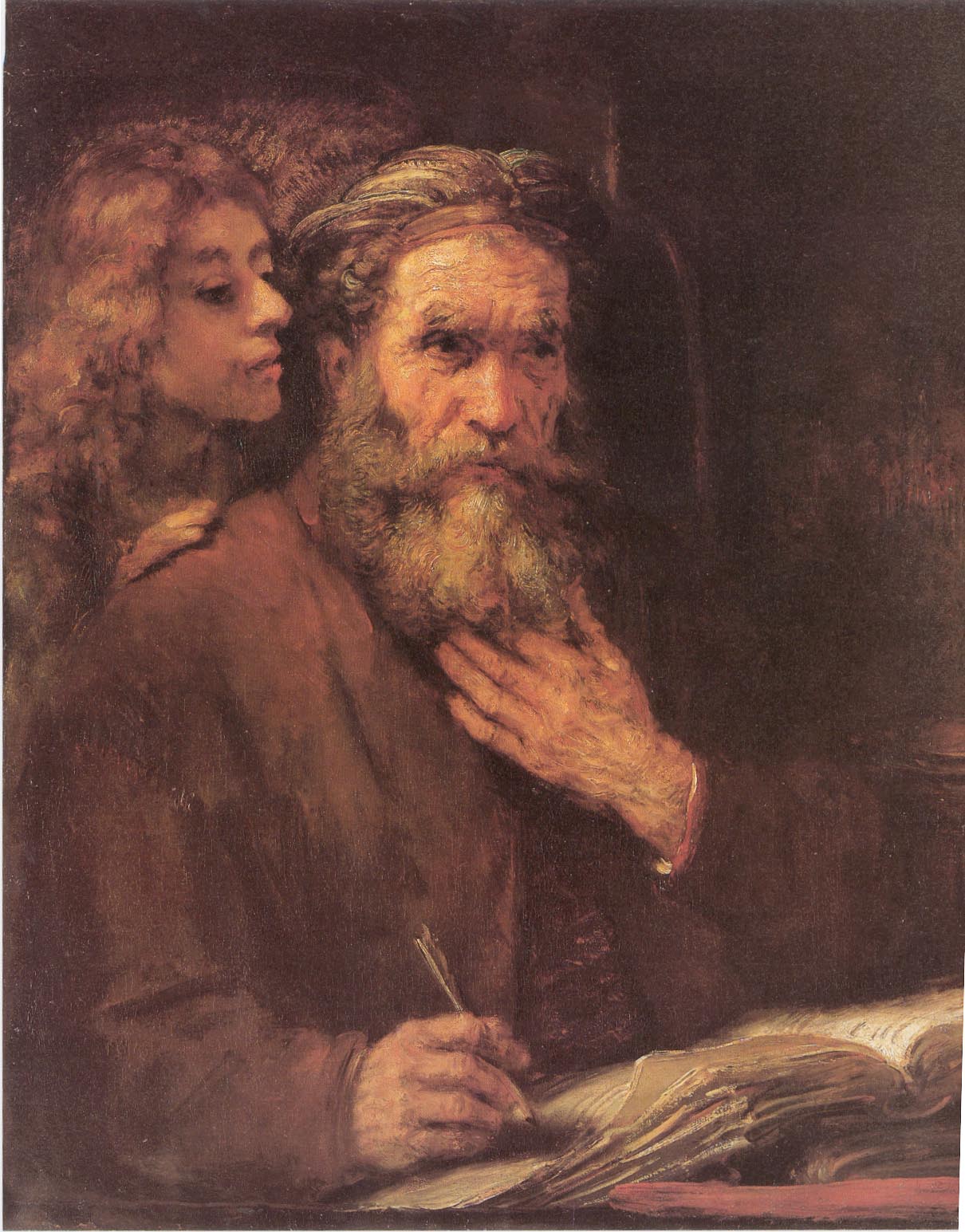
St. Matthew with his angel
Rembrandt

The lion of St. Mark
Carpaccio
In the background is Venice. The lion holds a book inscribed with Venice’s motto: Pax tibi Marce, evangelista meus (Peace to you, Mark, my evangelist; PAX/TIBI/MAR/CE/E/VANGELI/STA/MEUS).

Luke with his cow
Frans Hals
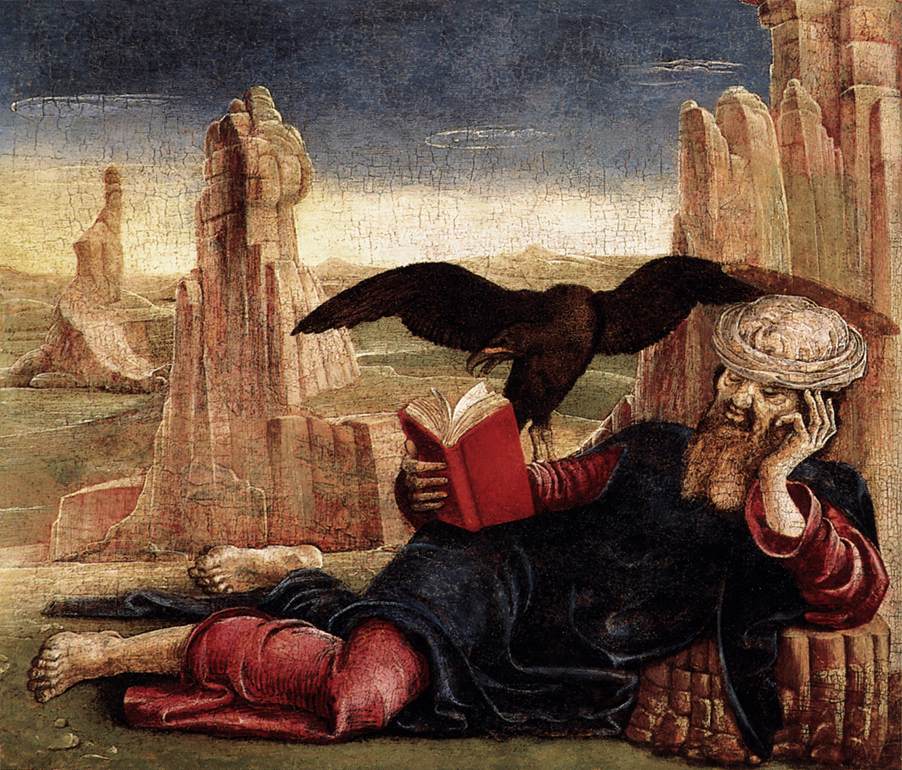
St. John the Evangelist on the Greek island of Patmos, with his eagle; he’s called “the evangelist” to distinguish him from John the Baptist; he’s the reputed author of the Gospel of John and the Book of Revelation; he’s said to have written Revelation on Patmos, after being exiled to Patmos by the Roman authorities.
© L. James Hammond 2013
feedback
visit Phlit home page
make a donation via PayPal
| Footnotes | |
| 1. | 1816 review of Emma, quoted here back |
| 1B. | If you like Austen movies, you’ll enjoy Sense and Sensibility (1995). I also recommend the movie Mansfield Park (1999), though it politicizes Austen’s novel by discussing slavery. back |
| 2. | “Jane Austen as Moralist and Humorist,” in the Norton Critical Edition of Pride and Prejudice. back |
| 3. | See “Pride Unprejudiced,” by Mark Schorer, The Kenyon Review, Vol. 18, No. 1 (Winter, 1956), pp. 72-91 back |
| 4. | Mary Lascelles, “The Narrative Art of Pride and Prejudice,” in the Norton Critical Edition of Pride and Prejudice. back |
| 5. | See “Pride Unprejudiced,” by Mark Schorer, The Kenyon Review, Vol. 18, No. 1 (Winter, 1956), pp. 72-91 back |
| 6. | Wikipedia back |